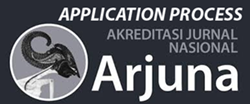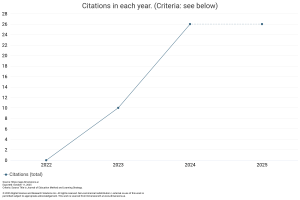Evaluating the Effectiveness of Innovative Learning Approaches in Teaching Biology to Secondary School Students: A Comparative Study of Traditional and Interactive Pedagogical Methods
DOI:
https://doi.org/10.59653/jemls.v2i03.779Keywords:
Biology, Innovative teaching, Educational paradigm, Diverse learning styleAbstract
As the landscape of education continues to evolve, it is crucial for educators to stay abreast of the innovative strategies and approaches in order to effectively prepare students for the complexities of the 21st century. This comprehensive review underscores the significance of embracing diverse and dynamic teaching methodologies to cultivate a deep and enduring passion for biology among school students. In order to address diverse learning styles and abilities, personalized learning strategies, differentiated instruction, and the incorporation of multimedia resources have been increasingly utilized to cater to individual student needs and promote inclusive in biology education. Furthermore, the implementation of formative assessments and feedback mechanisms has allowed for ongoing evaluation and adaptation of teaching methods to optimize student learning outcomes. Additionally, the integration of interdisciplinary studies, such as combining biology with technology, ethics, and environmental science, has provided students with a broader and more holistic perspective on biology and its relevance in the real world. By embracing innovative teaching strategy and staying attuned to the evolving needs of students, educators can cultivate a vibrant and engaging learning environment that empowers students to become informed and enthusiastic participants in the ever-expanding field of biology.
Downloads
References
Akar, E. Ö. (2011). Influence of Teacher Perceptions of Students on Teaching High School Biology. Eurasian Journal of Educational Research (EJER), (44).
Armbruster, P., Patel, M., Johnson, E., & Weiss, M. (2009). Active learning and student-centered pedagogy improve student attitudes and performance in introductory biology. CBE—Life Sciences Education, 8(3), 203-213.
Brigati, J. (2018). Student attitudes toward active learning vs. lecture in cell biology instruction. The American Biology Teacher, 80(8), 584-591.
Gambari, A. I., Yaki, A. A., Gana, E. S., & Ughovwa, Q. E. (2014). Improving Secondary School Students’ Achievement and Retention in Biology Through Video-Based Multimedia Instruction.
Ghafoor, H., Tabassum, R., & Shaheen, G. (2022). A Comparative Study to Find Effectiveness of Teaching Biology Through Low-Cost material as Teaching Aid and Traditional Method of Teaching at Secondary Level. International Research Journal of Management and Social Sciences, 3(1), 149-159.
Holstermann, N., Grube, D., & Bögeholz, S. (2010). Hands-on activities and their influence on students’ interest. Research in science education, 40, 743-757.
Kalaian, S. A., & Kasim, R. M. (2017). Effectiveness of various innovative learning methods in health science classrooms: a meta-analysis. Advances in Health Sciences Education, 22, 1151-1167.
Kareem, A. A. (2018). The use of multimedia in teaching biology and its impact on students’ learning outcomes. The Eurasia Proceedings of Educational and Social Sciences, 9, 157-165.
Kazeni, M. M. M. (2012). Comparative effectiveness of context-based and traditional teaching approaches in enhancing learner performance in life sciences (Doctoral dissertation, University of Pretoria).
Lu, Tan-Ni, Bronwen Cowie, and Alister Jones. "Senior high school student biology learning in interactive teaching." Research in Science Education 40 (2010): 267-289.
Martins-Omole, M. I., Yusuf, H. O., & Guga, A. (2016). Effects of concept mapping and experimental techniques in teaching biology in secondary schools in Federal Capital Territory Abuja, Nigeria. European Journal of Education Studies.
Mohan, S. (2015). Traditional vs. experiential: A comparative study of instructional methodologies on student achievement in New York City public schools. Sage Graduate School.
Nurutdinova, A. R., Perchatkina, V. G., Zinatullina, L. M., Zubkova, G. I., & Galeeva, F. T. (2016). Innovative teaching practice: traditional and alternative methods (challenges and implications). International journal of environmental and science education, 11(10), 3807-3819.
Odadžić, V., Miljanović, T., Mandić, D., Pribićević, T., & Županec, V. (2017). Effectiveness of the Use of Educational Software in Teaching Biology. Croatian Journal Educational/Hrvatski Casopis za Odgoj I Obrazovanje, 19(1).
Pop-Pacurar, I., & Ciascai, L. (2010). Biology School Textbooks and Their Role for Students' Success in Learning Sciences. Acta Didactica Napocensia, 3(1), 1-10.
Porozovs, J., Liepniece, L., & Voita, D. (2015). Evaluation of the teaching methods used in secondary school biology lessons. Signum Temporis, 7(1), 60.
Pribićević, T., Miljanović, T., Odadžić, V., Mandić, D., & Županec, V. (2017). The efficiency of interactive computer-assisted biology teaching in grammar schools. Croatian Journal of Education: Hrvatski časopis za odgoj i obrazovanje, 19(3), 803-839.
Renau, M. L. R. (2023). Exploring Methodological Approaches in Secondary Education in Castellón, Spain: A Comparative Analysis of Traditional, Blended, and Innovative Teaching. Futurity Education, 3(4), 232-254.
Subramaniam, Karthigeyan. "Student teachers’ conceptions of teaching biology." Journal of Biological Education 48, no. 2 (2014): 91-97.
Syafii, W., & Yasin, R. M. (2013). Problem solving skills and learning achievements through problem-based module in teaching and learning biology in high school. Asian Social Science, 9(12), 220.
Vo, H. M., Zhu, C., & Diep, N. A. (2017). The effect of blended learning on student performance at course-level in higher education: A meta-analysis. Studies in Educational Evaluation, 53, 17-28.
Yager, R. E., Engen, H. B., & Snider, B. C. (1969). Effects of the laboratory and demonstration methods upon the outcomes of instruction in secondary biology. Journal of Research in Science Teaching, 6(1), 76-86.
Županec, V. S., Radulović, B. N., Pribićević, T. Z., Miljanović, T. G., & Zdravković, V. G. (2018). Determination of educational efficiency and students’ involvement in the flipped biology classroom in primary school. Journal of Baltic Science Education, 17(1), 162.
Downloads
Published
How to Cite
Issue
Section
License
Copyright (c) 2024 Chandrasekhar Bhoi

This work is licensed under a Creative Commons Attribution-ShareAlike 4.0 International License.
Authors who publish with this journal agree to the following terms:
- Authors retain copyright and grant the journal right of first publication with the work simultaneously licensed under a Creative Commons Attribution-ShareAlike that allows others to share the work with an acknowledgement of the work's authorship and initial publication in this journal.
- Authors are able to enter into separate, additional contractual arrangements for the non-exclusive distribution of the journal's published version of the work (e.g., post it to an institutional repository or publish it in a book), with an acknowledgement of its initial publication in this journal.
- Authors are permitted and encouraged to post their work online (e.g., in institutional repositories or on their website) prior to and during the submission process, as it can lead to productive exchanges, as well as earlier and greater citation of published work (See The Effect of Open Access).
























